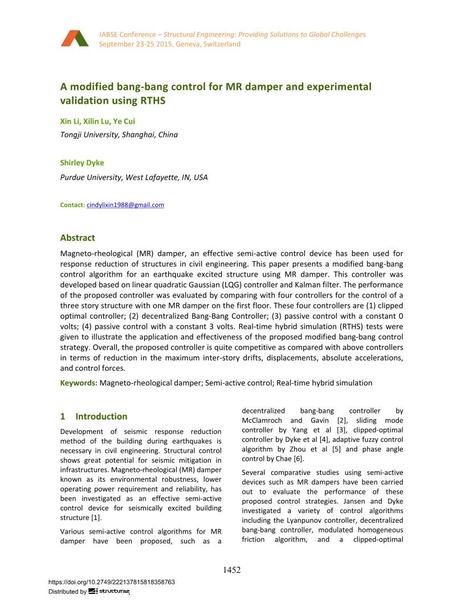A modified bang-bang control for MR damper and experimental validation using RTHS

|
|
|||||||||||
Détails bibliographiques
| Auteur(s): |
Xin Li
(Tongji University, Shanghai, China)
Xilin Lu (Tongji University, Shanghai, China) Ye Cui (Tongji University, Shanghai, China) Shirley Dyke (Purdue University, West Lafayette, IN, USA) |
||||
|---|---|---|---|---|---|
| Médium: | papier de conférence | ||||
| Langue(s): | anglais | ||||
| Conférence: | IABSE Conference: Structural Engineering: Providing Solutions to Global Challenges, Geneva, Switzerland, September 2015 | ||||
| Publié dans: | IABSE Conference Geneva 2015 | ||||
|
|||||
| Page(s): | 1452-1458 | ||||
| Nombre total de pages (du PDF): | 7 | ||||
| Année: | 2015 | ||||
| DOI: | 10.2749/222137815818358763 | ||||
| Abstrait: |
Magneto-rheological (MR) damper, an effective semi-active control device has been used for response reduction of structures in civil engineering. This paper presents a modified bang-bang control algorithm for an earthquake excited structure using MR damper. This controller was developed based on linear quadratic Gaussian (LQG) controller and Kalman filter. The performance of the proposed controller was evaluated by comparing with four controllers for the control of a three story structure with one MR damper on the first floor. These four controllers are (1) clipped optimal controller; (2) decentralized Bang-Bang Controller; (3) passive control with a constant 0 volts; (4) passive control with a constant 3 volts. Real-time hybrid simulation (RTHS) tests were given to illustrate the application and effectiveness of the proposed modified bang-bang control strategy. Overall, the proposed controller is quite competitive as compared with above controllers in terms of reduction in the maximum inter-story drifts, displacements, absolute accelerations, and control forces. |
||||
